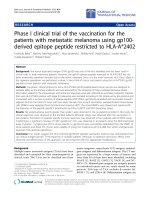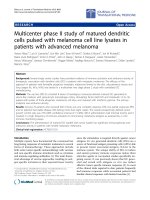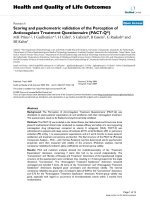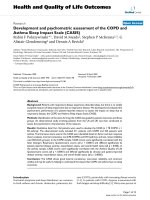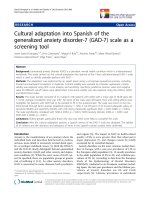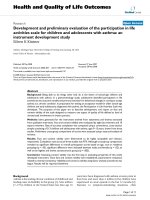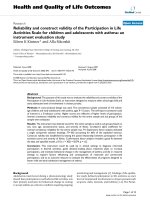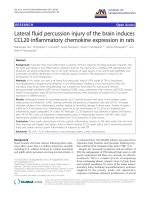Báo cáo hóa học: " Atomic Force Microscopy Study of the Kinetic Roughening in Nanostructured Gold Films on SiO2" ppt
Bạn đang xem bản rút gọn của tài liệu. Xem và tải ngay bản đầy đủ của tài liệu tại đây (366.2 KB, 7 trang )
NANO EXPRESS
Atomic Force Microscopy Study of the Kinetic Roughening
in Nanostructured Gold Films on SiO
2
F. Ruffino Æ M. G. Grimaldi Æ F. Giannazzo Æ
F. Roccaforte Æ V. Raineri
Received: 17 November 2008 / Accepted: 18 December 2008 / Published online: 6 January 2009
Ó to the authors 2009
Abstract Dynamic scaling behavior has been observed
during the room-temperature growth of sputtered Au films
on SiO
2
using the atomic force microscopy technique. By
the analyses of the dependence of the roughness, r, of the
surface roughness power, P(f), and of the correlation
length, n, on the film thickness, h, the roughness exponent,
a = 0.9 ± 0.1, the growth exponent, b = 0.3 ± 0.1, and
the dynamic scaling exponent, z = 3.0 ± 0.1 were inde-
pendently obtained. These values suggest that the
sputtering deposition of Au on SiO
2
at room temperature
belongs to a conservative growth process in which the Au
grain boundary diffusion plays a dominant role.
Keywords Dynamic scaling behavior
Kinetic roughening Atomic force microscopy
Gold SiO
2
Introduction
Thin films having 0.1 nm thickness play important roles in
various fields of modern day science and technology [1, 2].
In particular, the structure and properties of metal films on
non-metal surfaces are of considerable interest [3–6] due to
their potential applications in various electronic, magnetic,
and optical devices. Most of these properties change
drastically, when ultrathin films are formed from bulk
materials, because of the confinement effects. The study of
the morphology of thin films with the variation of thickness
gives an idea about the growth mechanism of these films
[7, 8]. This indicates the importance of such studies both
from basic theoretical understanding and applications
points of view. The study of morphology and the under-
standing of growth mechanisms are also essential to
prepare materials in controlled way for the desired prop-
erties. Scanning probe microscopy techniques, such as
atomic force microscopy (AFM), are important methodol-
ogies to study the surface morphology in real space [9–12].
The top surface can be imaged using an AFM and these
images provide information about the morphology and the
variation of roughness as a function of thickness and scan
length. This variation of roughness essentially gives the
height–height correlation and can be used to extract the
growth mechanism of the film [13].
All rough surfaces exhibit perpendicular fluctuations
which are characterized by a rms width r ¼ \ x; yðÞ
2
[
1=2
being zx; yðÞ¼hðx; yÞ\hx; yðÞ[ with h(x, y) the height
function and\….[the spatial average over a planar refer-
ence surface. Films grown under nonequilibrium condition
are expected to develop self-affine surfaces [7, 14], whose
rms widths scale with time t and the length L sampled as [15]
r L; tðÞ¼L
a
Ft=L
a=b
ð1Þ
where r LðÞ/L
a
for t=L
a=b
!1 and r tðÞ/t
b
for
t=L
a=b
! 0. The parameter 0 \ a \ 1 is defined as the
roughness exponent [16], and the parameter, b, as the
growth exponent. Actual self-affine surfaces are charac-
terized by an upper horizontal cutoff to scaling, or
correlation length, n, beyond which the surface width no
longer scales as L
a
, and eventually reaches a saturation
F. Ruffino (&) M. G. Grimaldi
Dipartimento di Fisica e Astronomia, MATIS CNR-INFM,
Universita
`
di Catania, via S. Sofia 64, I-95123 Catania, Italy
e-mail: francesco.ruffi
F. Giannazzo F. Roccaforte V. Raineri
Consiglio Nazionale delle Ricerche–Istituto per la
Microelettronica e Microsistemi, VIII Strada 5, I-95121 Catania,
Italy
123
Nanoscale Res Lett (2009) 4:262–268
DOI 10.1007/s11671-008-9235-0
value, r. Implicit in Eq. 1 is a correlation length which
increases with time as n / t
1=z
, where z = a/b is the
dynamic scaling exponent.
In thin films deposition methodologies in which the film
thickness, h, is proportional to the time of deposition, t,
then, in the asymptotical limits,
r hðÞ¼ah
b
ð2Þ
n hðÞ¼bh
1=z
ð3Þ
where a and b are the opportune proportionality constants.
Theoretical treatments of nonequilibrium film growth
typically employ partial differential equations involving
phenomenological expansions in the derivatives of a time-
dependent height function, h(x, y, t). The Kardar–Parisi–
Zhang (KPZ) equation [17] and the Siegert–Plischke (SP)
equation [8] are examples of this approach. The KPZ
equation concerns the nonconservative systems (it does not
conserve the particle number): in the nonconservative
dynamics the side growth is allowed with the creation of
voids and overhangs, but the relaxation mechanisms such
as desorption or diffusion are not dominant enough to
eliminate these defects completely. The KPZ equation for
nonequilibrium and nonconservative systems yields a =
0.3–0.4 and b = 0.24–0.25 for growth of a two-dimen-
sional surface [18, 19]. The SP equation concerns, instead,
nonequilibrium but conservative systems. For conservative
growth [8, 20–23] the primary relaxation mechanism is the
surface diffusion. Because the desorption of atoms and
formation of overhangs and voids are negligibly small, the
mass and volume conservation laws play an important role
in the growth. The SP equation for nonequilibrium and
conservative systems yields a = 1 and b = 0.25 for
growth of a two-dimensional surface [8]. The values of a
and b predicted by the theories for nonconservatives and
conservatives systems may vary depending on the cou-
plings with other effects.
Although extensive theoretical studies have predicted
many important features in the growth dynamics of thin
films, experimental works have to be performed to verify
these predictions. In this article, we report an AFM study of
the thickness dependence of rand n for a nanostructured thin
Au film deposited by sputtering at room temperature on a
SiO
2
substrate. By such, studies the value of a = 0.9 ± 0.1
and b = 0.3 ± 0.1 are determined. Independently, the value
of 1/z = 0.3 ± 0.1 is obtained. From these measured values,
we suggest that the growth of Au film on SiO
2
at room
temperature is consistent with a conservative growth pro-
cess. A comparison with theoretical and experimental
literature data on the growth of thin metal films is finally
performed. The Au/SiO
2
system has been chosen for two
primary reasons: (1) the Au/SiO
2
interface grows, at room
temperature, in the Volmer–Weber mode, and it is unreactive
and abrupt [24]. This fact simplifies the experimental anal-
yses allowing to neglect spurious effects on the interface
growth deriving from the reaction between the deposited film
and the substrate. From this fact, after all, follows that the
growth of Au film onSiO
2
at room temperature belongs to the
conservative class of dynamic process; (2) The Au/SiO
2
nanostructured system represents a widely investigated
material for nanoelectronic applications [25]—in such a
system, the reaching of an atomic level control of the
structural properties allow a manipulation of the nanoscale
electrical ones [25].
Experimental
A cz-\100[ silicon wafer (with resistivity, q 6
10
3
X cm) was used as starting substrate. It was initially
etched in 10% aqueous HF solution to remove the native
oxide. Then it was annealed at 1223 K for 15 min in O
2
in
order to grow an uniform, 10-nm thick, amorphous SiO
2
layer. A series of Au films were deposited onto the SiO
2
substrate by RF sputtering using an Emitech K5509
Sputter coater apparatus. The depositions were performed
at room temperature, with a base pressure of 10
-4
Pa.
Samples of increasing nominal Au thickness, h, were
deposited: 2 nm (sample 1), 8 nm (sample 2), 14 nm
(sample 3), 20 nm (sample 4), 26 nm (sample 5), 32 nm
(sample 6). In our experimental deposition conditions, the
thickness, h, of the deposited Au film is proportional to the
deposition time t: h = at being a 6:67 10
2
nm/s. The
nominal thickness of the deposited Au film was checked by
Rutherford backscattering analyses (using 2 MeV
4
He
?
backscattered ions at 165
°
). The evolution of Au film
morphology with the thickness, h, was analyzed by AFM
using a PSIA XE150 microscope operating in non-contact
mode and ultra-sharpened Si tips were used and substituted
as soon as a resolution loss was observed during the
acquisition. AFM images were analyzed by using the XEI
software. The XEI is the PSIA-AFM image processing and
analysis program. The XEI software allows users to extract
several information from the sample surface by utilizing
various analysis tools and also by providing the ability to
remove certain artifacts from scan data. For example, its
analysis functions include to profile tracer and region, line
measurement of height, line profile, power spectrum,
line histogram, regional measurement of height, average
roughness, volume, surface area, histogram, bearing ratio,
and grain analysis functions.
Nanoscale Res Lett (2009) 4:262–268 263
123
Results and Discussion
The change in morphology of the Au film as a function of its
thickness, h, has been followed by AFM. From such anal-
yses, the Au film, in all the samples, results to be formed by
spherical nanometric grains of increasing mean size [26].
As an example, Fig. 1 shows 5 9 5 lm AFM representa-
tive images of the samples: (a) the starting SiO
2
substrate,
(b) sample 1 (h = 2 nm), (c) sample 2 (h = 8 nm),
(d) sample 3 (h = 14 nm), (e) sample 4 (h = 20 nm), (f)
sample 5 (h = 26 nm), (g) sample 6 (h = 32 nm), respec-
tively. First, we obtained the roughness r for each sample
by the corresponding AFM images using the XEI software.
In particular, the value of r for each sample was calculated
by averaging the values obtained by five 5 9 5 lm AFM
images (for which the roughness results saturated with the
scan size L). The error in r was deducted by the averaging
procedure. Thus, Fig. 2 reports the values of r obtained as a
function of h: the experimental data (dots) were fitted by
Eq. 2 (continuous line) obtaining the growth exponent
b = 0.3 ± 0.1.
Furthermore, for each sample we calculated also the
averaged power spectrum from the spectra of each of the
512 linear traces. Thus, in contrast to r, the power spectra
are calculated from one-dimensional cross sections of the
surface. Each spectrum is the square of the surface
roughness amplitude per spatial frequency interval and the
integral over all frequencies is the mean-square surface
roughness within the measured bandwidth (r
2
). Thus,
Fig. 3 reports the calculated surface roughness power, P,as
a function of the frequency, f, concerning the representative
AFM images presented in Fig. 1: Figure 3a for the sample
1(h = 2 nm), Fig. 3b for the sample 2 (h = 8 nm), Fig. 3c
for the sample 3 (h = 14 nm), Fig. 3d for the sample 4
(h = 20 nm), Fig. 3e for the sample 5 (h = 26 nm),
and Fig. 3f for the sample 6 (h = 32 nm), respectively.
Fig. 1 a AFM image (5 lm 9 5 lm scan size) of the starting thermal SiO
2
substrate. b–g AFM images (5 lm 9 5 lm scan size) of the Au film
deposited on thermal SiO
2
with different thickness: b 2 nm, c 8 nm, d 14 nm, e 20 nm, f 26 nm, g 32 nm
264 Nanoscale Res Lett (2009) 4:262–268
123
The power spectra in Fig. 3 have two distinct regions. The
flat, low frequency part resembles uncorrelated white
noise. The sloped portion represents the correlated portion
of the surface roughness. To obtain the roughness exponent
a from this data, we fit the power law decay (in the linear
region in the log–log plot) to
Pf[ n
1
ÀÁ
¼
const
f
c
ð4Þ
and for c d
0
[27]
a ¼
c d
0
2
ð5Þ
where d
0
is the dimension of the cross section through the
data, which in this case equals 1. Figure 3 reports for each
power spectra the fit by Eq. 4 of the linear region (continuous
lines). The values of c
i
were obtained by averaging the values
obtained by five power spectra corresponding to five
5 9 5 lm AFM images for each sample. So we obtain
the values c
1
= c(h = 2 nm) = 2.4 ± 0.1, c
2
= c(h =
8 nm) = 2.6 ± 0.1, c
3
= c(h = 14 nm) = 3.4 ± 0.2, c
4
=
c(h = 20 nm) = 3.3 ± 0.1, c
5
= c(h = 26 nm) = 2.2 ±
0.1, and c
6
= c(h = 32 nm) = 2.9 ± 0.1 for the samples 1,
Fig. 2 Experimental (dots) values of the saturated surface roughness
of the Au film as a function of the film thickness and fit (continuous
line) by Eq. 2. The fit parameter b resulted b = 0.3 ± 0.1
Fig. 3 Representative surface
roughness power spectra for the
analyzed sample calculated by
the AFM images reported in
Fig. 1: a for the sample with a
thickness of 2 nm b of 8 nm,
c of 14 nm, d of 20 nm, e of
26 nm, f of 32 nm of Au
respectively. The continuous
lines represent the fit by Eq. 4.
The values of c
i
reported as
insets are calculated by such fits
Nanoscale Res Lett (2009) 4:262–268 265
123
2, 3, 4, 5, and 6, respectively. Using Eq. 5 the corresponding
values of a
i
were obtained. The value of the roughness
exponent a was obtained as the mean value: a = 0.9 ± 0.1.
By the values of b = 0.3 ± 0.1 and a = 0.9 ± 0.1 pre-
viously derived, the value of the dynamic scaling exponent
z = a/b = 2.9 ± 0.4 (or alternatively of 1/z = 0.3 ± 0.1)
is predicted. But now -z can be derived by the experimental
data to try confirmation of the theoretical predicted value. In
fact, to characterize the scale of correlations perpendicular to
the growing direction, the correlation frequency n
1
can be
used. It can be evaluated by the power spectra as the spatial
frequency where P(f) has fallen to 1/e of its saturation low
frequency value and above which r is correlated. Using the
five power spectra for each sample already used for the
calculation of the c
i
and performing the averaging procedure,
the values of n
1
¼ n h ¼ 2nmðÞ¼0:076 0:010ðÞlm,
n
2
¼ n h ¼ 8nmðÞ¼0:122 0:098ðÞlm, n
3
¼ n h ¼ 14ð
nmÞ¼ 0:139 0:095ðÞlm, n
4
¼ n h ¼ 20 nmðÞ¼0:159ð
0:010Þlm, n
5
¼ n h ¼ 26 nmðÞ¼0:178 0:009ðÞlm,
n
6
¼ n h ¼ 32 nmðÞ¼0:189 0:096ðÞlm for the correla-
tion lengths for the samples 1, 2, 3, 4, 5, and 6, respectively,
were obtained. Figure 4 reports as dots, in a log–log scale,
such values as a function of the film thickness, h. The con-
tinuous line is the fit by Eq. 3 allowing the determination of
1/z = 0.3 ± 0.1 in agreement with the predicted value.
Finally, from the AFM analyses reported in Fig. 1, statistical
data on the radius, area and volume of the Au nanometric
grains forming the film can be obtained. The XEI software
for the analyses of the AFM images allow to obtain the
distribution of the grains radii, R, and of the grains areas S by
a procedure consisting in the definition of each grain area by
the surface image sectioning of a plane that was positioned at
the half grain height. As a consequence, the distribution of
the grains radii R, surface areas, S, and volumes, V can be
extracted. By such distributions, the mean grain radius,\R[,
the mean grain area,\S[, and the mean grain volume\V[
can be extracted with the respective statistical errors.
Therefore, Fig. 5a–c report\R[,\S[, and\V[as a function
of the film thickness h. As a final remark, it is worth to note
that Fig. 5c, being \V[ / \R[
3
indicates clearly a grain
growth scaling law \R[ / h
1=3
. Since the dynamical scal-
ing theories predict \R[ / h
1=z
[8] then also such a data
conduct tothe results z = 3 forthe dynamic scaling exponent.
Now, we turn to the comparison of the data presented in
this study with experimental and theoretical literature studies.
The values obtained by us in this study are comparable to
those reported by Chevrier et al. [28](b = 0.25–0.32) for
vapor-deposited Fe on Si at 323 K, by G. Palasantzas and
J. Krim [29](a = 0.82 ± 0.05, b = 0.29 ± 0.06 and z =
2.5 ± 0.5) for room-temperature vapor-deposited Ag film on
quartz. But they do not coincide with the values reported by
You et al. [30](a = 0.42, b = 0.40) for room-temperature
sputtered Au film on Si, to those reported by Fanfoni et al.
[31] and Placidi et al. [32] for the molecular beam epitaxy
Fig. 4 Experimental (dots) values of the correlation length for the Au
film as a function of the film thickness and fit (continuous line) by
Eq. 3. The fit parameter 1/z resulted 1/z = 0.3 ± 0.1
Fig. 5 Experimental evolution (dots) of the mean grain radius \R[
(a), mean grain surface area\S[(b), and mean grain volume\V[(c)
as a function of the thickness film h. The lines are only guide for theeyes
266 Nanoscale Res Lett (2009) 4:262–268
123
dynamical growth of silver islands on GaAs(001)-(2 9 4)
(z = 1.5 ± 0.2 and z = 4.2 ± 0.4, respectively) andto those
reported by Rosei et al. [33] for reactive-deposited Ge on
Si(1111) (z = 0.70 ± 0.20). We can attribute the difference
of our results from those of You et al. to the different used
substrates used since though Au is unreactive with SiO
2
,itis
reactive with Si [34] and to the lower substrate temperature.
The difference with respect to the values of Fanfoni et al.,
Placidi et al. and Rosei et al. can be attributed to differences
in film deposition conditions. We believe that our values of
a = 0.9 ± 0.1, b = 0.3 ± 0.1 and 1/z = 0.3 ± 0.1 for
room-temperature sputtered Au films are more consistent
with a conservative deposition process (i.e. prediction of the
SP equation) rather than a nonconservative one (i.e. predic-
tion of the KPZ equation). Other experiments that charac-
terize self-affine fractals using different techniques [35–37]
indicate that the values of a measured from metal thin films
range from 0.65 to 0.95, which are indeed higher than that
predicted by the nonconservative growth models [17–19].
The exponents obtained in this experiment are thus more
consistent with the results of conservative growth models
[20–23]. A justification of this fact can be found in the
microscopic mechanism governing the Au film growth on
SiO
2
at room temperature. Our recent data [26] suggest that
during the Au sputter deposition at room temperature the film
growth is driven by the Au grain boundary diffusion with a
diffusion coefficient D
gb
ð300 KÞ2 10
17
cm
2
=s (rather
than an Au surface diffusion, since the surface diffusion
coefficient of Au on SiO
2
is very small at room temperature,
D
Au=SiO
2
ð300 KÞ7 10
26
cm
2
=s[24]). In fact, the AFM
analyses in connection with transmission electron micros-
copy analyses allow to conclude that the Au film is formed by
three-dimensional nanometric grains that grows as ‘‘normal
grains’’ for thickness in the 0.33 nm. For higher thickness,
together with the normal grain growth, the growth of
‘‘abnormal large grains’’ is observed. The normal grain
growth appears to be (at room temperature) controlled by Au
diffusion on grain boundaries (rather than by Au surface
diffusion) while the abnormal grain growth process appears to
be driven by the differences between surface energies of the
normal and abnormal grains, so that grains with favored ori-
entations grow at a higher rate (with respect to the normal
grain growth rate) by annihilating the surrounding normal
grains. We believe, thus, that, during the deposition process,
the overhangs and voids are unlikely to appear in the growth
of the film because the Au grain boundary diffusion plays a
dominant role.
Conclusion
An AFM study of the dynamic evolution of a growing
interface was carried out for room-temperature Au sputtered
onto a SiO
2
substrate. The analyses of AFM images of the Au
film allowed us to derive the roughness, r, the surface
roughness power, P(f), and the correlation length, n,asa
function of the film thickness, h. Analyzing such depen-
dences the roughness exponent, the growth exponent and the
dynamic scaling exponent were independently obtained:
a = 0.9 ± 0.1, b = 0.3 ± 0.1 and z = 3.0 ± 0.1. These
values suggest that the sputtering deposition of Au on SiO
2
at
room temperature belongs to a conservative growth process
in which the Au grain boundary diffusion plays a dominant
role. This study suggests further analyses concerning, for
example, the dependence of the exponents a, b, and z on the
substrate temperature during the film deposition (such as
pointed out in the experimental study of You et al. [30] for
the case of Au on Si), on the rate deposition (such as pointed
out by Collins et al. [38]) and the extension of the experi-
mental investigation to other systems that could present
nonequilibrium conservative or nonconservative dynami-
cal growth mechanisms (e.g., Pd/SiO
2,
Au/SiC, Pd/SiC,
Au/GaN, Pd/GaN, Pd/Si).
References
1. M. Ohring, The Materials Science of Thin Films (Academic
Press, New York, 1992)
2. D.L. Smith, Thin Film Deposition (McGraw-Hill, New York,
1995)
3. W.G. Schmidt, F. Bechstedt, G.P. Srivastava, Surf. Sci. Rep. 25,
141 (1996). doi:10.1016/S0167-5729(96)00006-4
4. C.T. Campbell, Surf. Sci. Rep. 27, 1 (1997). doi:10.1016/S0167-
5729(96)00011-8
5. S. Shanmugam, B. Viswanathan, T.K. Varadarajan, Nanoscale
Res. Lett. 2, 175 (2007). doi:10.1007/s11671-007-9050-z
6. P.S. Kishore, B. Viswanathan, T.K. Varadarajan, Nanoscale Res.
Lett. 3, 14 (2008). doi:10.1007/s11671-007-9107-z
7. A L. Barabasi, H.E. Stanley, Fractal Concepts in Surface
Growth (Cambridge University Press, Cambridge, 1995)
8. M. Siegert, M. Plischke, Phys. Rev. Lett. 73, 1517 (1994). doi:
10.1103/PhysRevLett.73.1517
9. R. Wiesendanger, Scanning Probe Microscopy and Spectroscopy
(Cambridge University Press, Cambridge, 1994)
10. D. Sarid, Scanning Force Microscopy with Applications to
Electric, Magnetic and Atomic Forces (Oxford University Press,
Oxford, 1994)
11. S R. Jian, I Ju. Teng, P F. Yang, Y S. Lai, J M. Lu,
J G. Chang, S P. Ju, Nanoscale Res. Lett. 3, 186 (2008). doi:
10.1007/s11671-008-9134-4
12. S R Jian, J Y. Juang, Nanoscale Res. Lett. 3, 249 (2008). doi:
10.1007/s11671-008-9144-2
13. J.K. Basu, S. Hazra, M.K. Sanyal, Phys. Rev. Lett. 82, 4675
(1999). doi:10.1103/PhysRevLett.82.4675
14. F. Family, T. Vicsek, Dynamics of Fractals Surfaces (World
Scientific, Singapore, 1991)
15. F. Family, T. Vicsek, J. Phys. A 18, L75 (1985). doi:10.1088/
0305-4470/18/2/005
16. J. Krim, J.O. Indekeu, Phys. Rev. E Stat. Phys. Plasmas Fluids
Relat. Interdiscip. Topics 48, 1576 (1993). doi:10.1103/PhysRevE.
48.1576
Nanoscale Res Lett (2009) 4:262–268 267
123
17. M. Kardar, G. Parisi, Y C. Zhang, Phys. Rev. Lett. 56, 889
(1986). doi:10.1103/PhysRevLett.56.889
18. J.M. Kim, J.M. Kosterlitz, Phys. Rev. Lett. 62, 2289 (1989).
doi:10.1103/PhysRevLett.62.2289
19. B.M. Forrest, L H. Tang, Phys. Rev. Lett. 64, 1405 (1990).
doi:10.1103/PhysRevLett.64.1405
20. J. Villain, J. Phys. I 1, 19 (1991)
21. D.E. Wolf, J. Villain, Europhys. Lett. 13, 389 (1990). doi:10.1209/
0295-5075/13/5/002
22. Z W. Lai, S. Das Sarma, Phys. Rev. Lett. 66, 2348 (1991). doi:
10.1103/PhysRevLett.66.2348
23. L H. Tang, T. Nattermann, Phys. Rev. Lett. 66, 2899 (1991). doi:
10.1103/PhysRevLett.66.2899
24. F. Ruffino, A. Canino, M.G. Grimaldi, F. Giannazzo, C. Bongi-
orno, F. Roccaforte, V. Raineri, J. Appl. Phys. 101, 064306 (2007).
doi:10.1063/1.2711151
25. F. Ruffino, M.G. Grimaldi, F. Giannazzo, F. Roccaforte,
V. Raineri, Appl. Phys. Lett. 83, 263108 (2006). doi:10.1063/
1.2424433
26. F. Ruffino, C. Bongiorno, F. Giannazzo, F. Roccaforte, V. Raineri,
C. Spinella, V. Raineri, J. Appl. Phys. (submitted)
27. R.F. Voss, in Scaling Phenomena in Disordered Systems, ed. by
R. Pynn, A. Skejeltorp (Plenum, New York, 1985)
28. J. Chevrier, V. Le Thanh, R. Buys, J. Derrien, Eoruphys. Lett. 16,
737 (1991). doi:10.1209/0295-5075/16/8/006
29. G. Palasantzas, J. Krim, Phys. Rev. Lett. 73, 3564 (1994). doi:
10.1103/PhysRevLett.73.3564
30. H. You, R.P. Chiarello, H.K. Kim, K.G. Vandervoort, Phys. Rev.
Lett. 70, 2900 (1993). doi:10.1103/PhysRevLett.70.2900
31. M. Fanfoni, E. Placidi, F. Arciprete, F. Patella, N. Motta,
A. Balzarotti, Surf. Sci. 445, L17 (2000). doi:10.1016/S0039-
6028(99)01099-7
32. E. Placidi, M. Fanfoni, F. Arciprete, F. Patella, N. Motta, A.
Balzarotti, Mater. Sci. Eng. B 69–70, 243 (2000). doi:10.1016/
S0921-5107(99)00303-7
33. F. Rosei, N. Motta, A. Sgarlata, G. Capellini, F. Boscherini, Thin
Solid Films 36, 29 (2000). doi:10.1016/S0040-6090(00)00829-4
34. J.F. Chang, T.F. Young, Y.L. Yang, H.Y. Ueng, T.C. Chang,
Mater. Chem. Phys. 83, 199 (2004). doi:10.1016/S0254-0584(03)
00240-2
35. R.P. Chiarello, V. Panella, J. Krim, C. Thompson, Phys. Rev.
Lett. 67, 3408 (1991). doi:10.1103/PhysRevLett.67.3408
36. M.W. Mitchell, A. Bonnell, J. Mater. Res. 5, 2244 (1990).
doi:10.1557/JMR.1990.2244
37. J.M. Go
´
mez-Rodriguez, A.M. Baro
´
, R.C. Salvezza, J. Vac. Sci.
Technol. B 9, 495 (1991). doi:10.1116/1.585554
38. G.W. Collins, S.A. Letts, E.M. Fearon, R.L. McEachern,
T.P. Bernat, Phys. Rev. Lett. 73, 709 (1994)
268 Nanoscale Res Lett (2009) 4:262–268
123

